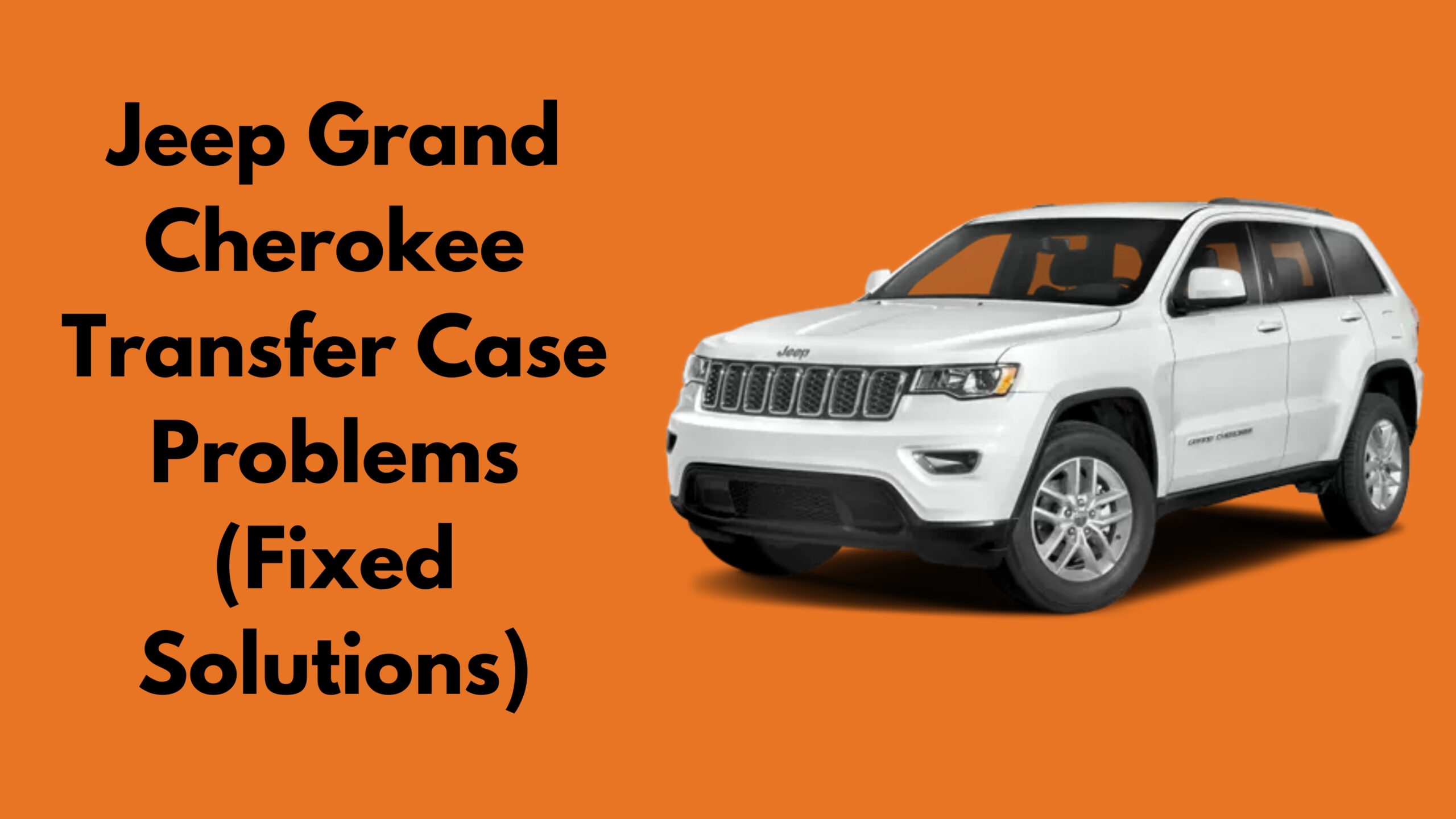The Jeep Grand Cherokee is a popular SUV known for its ruggedness and versatility.
It is the best model because of its unique features and comfort.
However, like all the other vehicles, it has its share of problems, particularly with the transfer case.
Most people get frustrated when they face a problem with their Jeep Grand Cherokee case.
You don’t have to get frustrated. After all, you are at the right place, because you are going to fix this problem on your own.
In this blog article, I’m going to discuss the common issues associated with the transfer case in the Jeep Grand Cherokee.
I will also discuss the cause of this problem and the solutions to fix it easily at home on your own.

What is a Transfer Case?
The transfer case is an essential component of four-wheel drive (4WD) systems. It allows the power to be distributed to both the front and rear axles.
It plays a major role in managing the vehicle’s traction and performance, particularly in off-road conditions.
Understanding its function can help you appreciate why issues with this component are significant.
Common Transfer Case Issues
Transfer cases in Jeep Grand Cherokees, especially those equipped with the Quadra-Drive system, are known for their vulnerability.
Some common problems include:
- Clutch Wear: With time, the clutches within the transfer case can wear out, which leads the transfer case to failure.
- Inconsistent Tire Sizes: If you are using different sizes of tires, it can cause the transfer case to engage unnecessarily, leading to premature wear.
- Electrical Failures: Issues with the transfer case control module can also cause malfunctioning in the transfer cases.
Why Do Transfer Cases Fail?
There are several factors that contribute to the failure of transfer cases in Jeep Grand Cherokees.
If you have a better understanding of these factors, you can avoid costly repairs.
Tire Size Discrepancies
One of the most significant factors that lead to transfer case failure is mismatched tire sizes.
When drivers replace only one or two tires of their Jeep, they don’t really focus on the size of the tires.
The difference in sizes can cause the transfer case to engage clutches unnecessarily.
This problem occurs because the computer perceives a difference in wheel speed.
Because of this, it assumes the Jeep Grand Cherokee is on slippery terrain, prompting it to engage in four-wheel drive.
Clutch Wear and Tear
The problem with the clutch in Jeep Grand Cherokee is another common issue.
The clutches inside the transfer case can wear out due to excessive engagement caused by tire discrepancies or simply from regular use.
When the clutches of your Jeep Grand Cherokee wear out, they can lead to significant performance issues.
If the condition of your Jeep clutch is very bad, it is very good to replace your clutch with a new one.
Electrical Problems
If there is any electrical problem with your Jeep Grand Cherokee, it can play a major role in transfer case failures.
If the transfer case control module malfunctions, it can send incorrect signals.
If your control module is not getting the correct signal, it can lead to improper engagement or disengagement of the transfer case.
Signs of a Failing Transfer Case
Identifying the signs of a failing transfer case early can save you from expensive repairs.
Here are some symptoms to watch out for:
- Service Four-Wheel Drive Message: If this warning appears on your dashboard, it could indicate a problem with the transfer case.
- Unusual Noises: Grinding or clunking sounds when engaging or disengaging four-wheel drive may signal a failing transfer case.
- Difficulty Shifting: If you experience difficulty shifting between two-wheel and four-wheel drive, it may be due to transfer case issues.
Repairing the Transfer Case
If you suspect your Jeep Grand Cherokee has a transfer case issue, it’s essential to address it promptly. Here are some repair options:
Rebuilding vs. Replacing
When it comes to repair, you generally have two options: rebuild or replace.
Rebuilding means disassembling the transfer case, replacing worn components, and reassembling it.
This option is very cost-effective but it may only work sometimes to restore the unit to its original performance.
Replacing the transfer case with a new or remanufactured unit is often the more reliable solution, especially if the original unit has sustained significant damage.
While this option is more expensive, it ensures that you have a fully functional transfer case.
Cost Considerations
If your Jeep Grand Cherokee is having a transfer case problem and you are not able to fix it, it is better to replace your transfer case.
The cost of repairing or replacing a transfer case can depend on the model of your Jeep and the quality of the transfer case.
But on average, you can expect to pay between $2,000 to $3,000 for a replacement, including parts and labor.
It also depends on the location you are living.
Preventive Measures
Taking steps to prevent transfer case issues can save you time and money in the long run.
Here are some preventive measures:
- Regular Maintenance: Regularly servicing your vehicle can help identify potential issues before they escalate.
- Check Tire Sizes: Always ensure that all four tires are of equal size and wear to avoid unnecessary strain on the transfer case.
- Monitor Warning Signs: Pay attention to warning lights and unusual noises, addressing them promptly.
Conclusion
In conclusion, the transfer case in your Jeep Grand Cherokee is amazing for optimal performance, especially when tackling challenging terrains.
This problem can be frustrating for the users, but if you understand the problem you can fix it on your own at home.
If you understand the common issues associated with this component, recognizing the warning signs of failure, and taking preventive measures can help ensure your vehicle remains in top condition.
If you experience any symptoms of transfer case problems, consult a professional mechanic to evaluate and address the issue promptly.
By staying informed and proactive, you can enjoy all the capabilities that your Jeep Grand Cherokee.
Frequently Asked Question
How do I know if my Jeep transfer case is bad?
If you don’t know how to know if your Jeep transfer case is bad, I will give you simple instructions.
Most people see this problem according to their understanding and ideas, but I will discuss the most common indications.
If your Jeep is whining, growling, and humming your Jeep transfer case is not in a good situation.
If you are facing any of these problems, it is time to change the transfer case of your Jeep.
Can you drive a Jeep with a bad transfer case?
If we talk about driving a Jeep in general, we can drive a Jeep until or unless we have petrol in our Jeep.
Technically, we can drive a Jeep with a broken transfer case. But driving your Jeep with a bad transfer case is not recommended.
It is recommended that you take it in for repairs or a replacement as soon as you notice issues.
What makes a transfer case go bad?
If you don’t know if your Jeep transfer case is bad or good, you can know by some indications that I will tell you.
If your Jeep transfer case is in good condition, your Jeep will work well. But if your Jeep has a low fluid level (caused by leaks) it can lead your transfer case to bad.
Also, lack of maintenance can cause your transfer case to get in bad condition.
Which Jeep transfer case is best?
There are so many transfer cases available in the marketplace. Everyone refers to a transfer case according to his assumption.
It also heavily depends on your Jeep. But for me, the best transfer case is NP241OR or Rock-Trac case.
This case is the best case for the Jeep Grand Cherokee.

